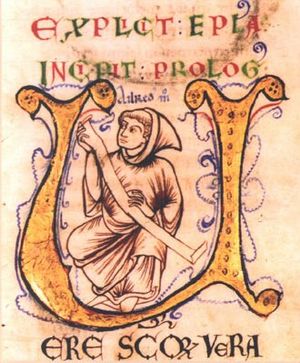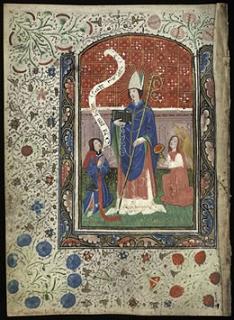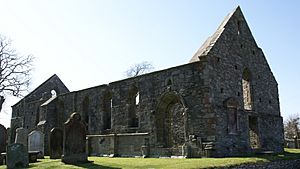Vita Sancti Niniani facts for kids
Quick facts for kids Vita Sancti Niniani |
|
|---|---|
| "The Life of Saint Ninian" | |
| Author(s) | Ailred of Rievaulx |
| Patron | Perhaps a Bishop of Galloway |
| Language | medieval Latin |
| Date | composed mid-1100s |
| Authenticity | authentic |
| Principal manuscript(s) | 1) British Library Cotton Tiberius D iii 2) Bodleian Library Laud Miscellaneous 668 |
| First printed edition | John Pinkerton, 1789 |
| Genre | prose hagiography |
| Subject | Saint Ninian |
| Setting | Anglo-Saxon Whithorn and neighbourhood |
| Period covered | unclear, early middle ages |
| Sources | 1) Bede's Historia ecclesiastica gentis Anglorum 2) Liber de Vita et Miraculis (lost) |
The Vita Sancti Niniani (which means "Life of Saint Ninian") is an old Latin language story written in the mid-1100s. It's a type of book called a hagiography, which tells the life story of a Christian saint. This book was written in northern England by a person named Ailred of Rievaulx.
The story is about a church leader named Uinniau or Finnian. But because of mistakes when copying the text, his name became "Ninian" over time. So, the "Saint Ninian" in this book is like a story character based on a real person, but with a different name. The Vita shares "Ninian's" life and describes ten amazing things, called miracles, that he supposedly did. Six of these happened while he was alive, and four happened after he died.
Contents
Who Wrote This Story?
Most historians agree that Ailred of Rievaulx wrote the Vita Sancti Niniani. He was a famous writer and monk from the 12th century.
Some people in the past wondered if he really wrote it. This was because his own biographer, Walter Daniel, didn't list it among Ailred's works. However, in one of the old copies of the book, Ailred is clearly named as the author. Also, in another copy, the Vita is found in a collection of other books known to be by Ailred. Because of this, most experts still believe Ailred wrote it. It might have been the first saint's life story he ever wrote.
Old Copies of the Story
The Vita Sancti Niniani survives today in two main old copies, called manuscripts. One is kept in the British Library, and the other is in the Bodleian Library. There might have been other copies long ago that are now lost.
The story was first printed in a book in 1789 by John Pinkerton. Later, other scholars also printed the Latin text. People have also translated the story into English. These translations help more people read about Saint Ninian's life and the miracles described in the book.
What Happens in the Story?
The Vita Niniani is mostly a collection of amazing stories about "Ninian's" miracles. It's written like a biography, telling parts of his life.
The book starts with an introduction. It explains why the author wrote the story and what old sources he used. Then, the main story begins:
- Becoming a Christian: Ninian becomes a very devoted Christian.
- Journey to Rome: He travels to Rome and becomes a bishop.
- Building a Church: When he returns to Britain, he builds a stone church in a place called Whithorn.
Then, the book tells about several miracles:
- King's Blindness: A king named Tudwallus makes fun of Ninian and becomes blind. But when he realizes Ninian's power, he is cured.
- Baby Speaks: A pregnant girl blames an innocent priest for being her baby's father. Ninian makes the baby speak to reveal the real father. This proves the priest was innocent.
- Converting the Picts: Ninian is said to have converted the "southern Picts" (an ancient people) to Christianity.
- Magic Leeks: Ninian makes leeks (a type of vegetable) appear in a garden.
- Bringing Back to Life: He brings a robber chief back to life after the man was attacked by a bull.
- Protected Book: Ninian often read psalms (holy songs) from a small book. God would protect him and his book from the rain. One day, Ninian had a bad thought while reading in the rain. The protection disappeared, and he and his book got wet. When he realized his mistake, the protection returned.
- Saving a Novice: Ninian saves a young monk (a novice) who was sailing in a small boat called a coracle to escape punishment.
Finally, Ninian dies and goes to Heaven.
Miracles After Death
The second part of the book tells four miracles that happened after Ninian died:
- Deformed Son Cured: A family takes their son, who has a physical problem, to Ninian's shrine (a holy place). Ninian appears to them in a dream, and their son is cured.
- Skin Disease Healed: A man named Aethelfrith is cured of a skin disease through prayer at the shrine.
- Blind Girl Sees: A girl named Deisuit, who is blind, gets her sight back after visiting Ninian's shrine.
- Lepers Cured: Two people with leprosy are cured after bathing at Ninian's special well.
Ailred ends the story by saying that these are just a few of the many miracles Ninian performed. He says that miracles continued to happen even up to his own time.
Why Was This Story Written?
Historians believe Ailred wrote this book because a new bishop in a place called Galloway asked him to. The bishops wanted to make their church more important and well-known to the wider world. Ailred was a good choice because he had connections with the local ruler, King Fergus of Galloway.
Ailred's book was the first to use the spelling "Ninian." This name came from a copying mistake of an earlier name, "Uinniau." So, Ailred's work helped create a "new" saint, even though the stories were based on an older person. The name "Ninian" probably wasn't known to the local people before this book.
The real person, Uinniau, was known by different names in different places and times. This is because of how names changed in different languages and how scribes (people who copied books) made mistakes. For example, Uinniau is thought to be the same person as Finnian of Movilla, another saint.
Even with Ailred's book, the original saint Uinniau was still honored in some parts of Scotland. For example, a place called Kilwinning (meaning "church of Uinniau") continued to worship "Saint Winnin" or "Saint Finan." However, with the support of the church leaders, the cult of "Saint Ninian" grew very popular after Ailred's book was written. It became one of the most important saints in Scotland in the Late Middle Ages.




